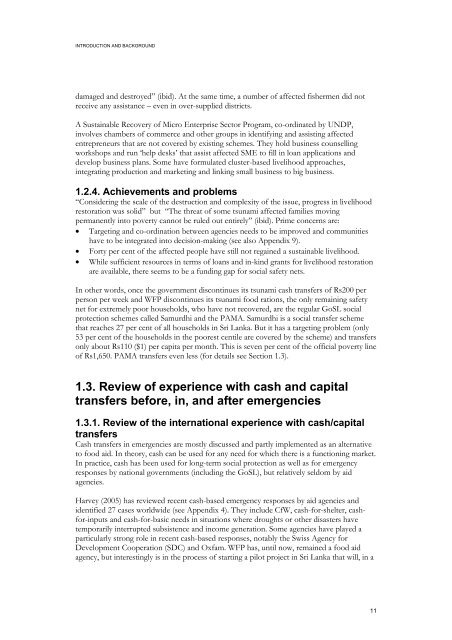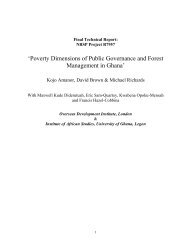Feasibility study on a capital-based income generation scheme for ...
Feasibility study on a capital-based income generation scheme for ...
Feasibility study on a capital-based income generation scheme for ...
Create successful ePaper yourself
Turn your PDF publications into a flip-book with our unique Google optimized e-Paper software.
INTRODUCTION AND BACKGROUND<br />
damaged and destroyed” (ibid). At the same time, a number of affected fishermen did not<br />
receive any assistance – even in over-supplied districts.<br />
A Sustainable Recovery of Micro Enterprise Sector Program, co-ordinated by UNDP,<br />
involves chambers of commerce and other groups in identifying and assisting affected<br />
entrepreneurs that are not covered by existing <strong>scheme</strong>s. They hold business counselling<br />
workshops and run ‘help desks’ that assist affected SME to fill in loan applicati<strong>on</strong>s and<br />
develop business plans. Some have <strong>for</strong>mulated cluster-<strong>based</strong> livelihood approaches,<br />
integrating producti<strong>on</strong> and marketing and linking small business to big business.<br />
1.2.4. Achievements and problems<br />
“C<strong>on</strong>sidering the scale of the destructi<strong>on</strong> and complexity of the issue, progress in livelihood<br />
restorati<strong>on</strong> was solid” but “The threat of some tsunami affected families moving<br />
permanently into poverty cannot be ruled out entirely” (ibid). Prime c<strong>on</strong>cerns are:<br />
• Targeting and co-ordinati<strong>on</strong> between agencies needs to be improved and communities<br />
have to be integrated into decisi<strong>on</strong>-making (see also Appendix 9).<br />
• Forty per cent of the affected people have still not regained a sustainable livelihood.<br />
• While sufficient resources in terms of loans and in-kind grants <strong>for</strong> livelihood restorati<strong>on</strong><br />
are available, there seems to be a funding gap <strong>for</strong> social safety nets.<br />
In other words, <strong>on</strong>ce the government disc<strong>on</strong>tinues its tsunami cash transfers of Rs200 per<br />
pers<strong>on</strong> per week and WFP disc<strong>on</strong>tinues its tsunami food rati<strong>on</strong>s, the <strong>on</strong>ly remaining safety<br />
net <strong>for</strong> extremely poor households, who have not recovered, are the regular GoSL social<br />
protecti<strong>on</strong> <strong>scheme</strong>s called Samurdhi and the PAMA. Samurdhi is a social transfer <strong>scheme</strong><br />
that reaches 27 per cent of all households in Sri Lanka. But it has a targeting problem (<strong>on</strong>ly<br />
53 per cent of the households in the poorest centile are covered by the <strong>scheme</strong>) and transfers<br />
<strong>on</strong>ly about Rs110 ($1) per capita per m<strong>on</strong>th. This is seven per cent of the official poverty line<br />
of Rs1,650. PAMA transfers even less (<strong>for</strong> details see Secti<strong>on</strong> 1.3).<br />
1.3. Review of experience with cash and <strong>capital</strong><br />
transfers be<strong>for</strong>e, in, and after emergencies<br />
1.3.1. Review of the internati<strong>on</strong>al experience with cash/<strong>capital</strong><br />
transfers<br />
Cash transfers in emergencies are mostly discussed and partly implemented as an alternative<br />
to food aid. In theory, cash can be used <strong>for</strong> any need <strong>for</strong> which there is a functi<strong>on</strong>ing market.<br />
In practice, cash has been used <strong>for</strong> l<strong>on</strong>g-term social protecti<strong>on</strong> as well as <strong>for</strong> emergency<br />
resp<strong>on</strong>ses by nati<strong>on</strong>al governments (including the GoSL), but relatively seldom by aid<br />
agencies.<br />
Harvey (2005) has reviewed recent cash-<strong>based</strong> emergency resp<strong>on</strong>ses by aid agencies and<br />
identified 27 cases worldwide (see Appendix 4). They include CfW, cash-<strong>for</strong>-shelter, cash<strong>for</strong>-inputs<br />
and cash-<strong>for</strong>-basic needs in situati<strong>on</strong>s where droughts or other disasters have<br />
temporarily interrupted subsistence and <strong>income</strong> generati<strong>on</strong>. Some agencies have played a<br />
particularly str<strong>on</strong>g role in recent cash-<strong>based</strong> resp<strong>on</strong>ses, notably the Swiss Agency <strong>for</strong><br />
Development Cooperati<strong>on</strong> (SDC) and Oxfam. WFP has, until now, remained a food aid<br />
agency, but interestingly is in the process of starting a pilot project in Sri Lanka that will, in a<br />
11
















